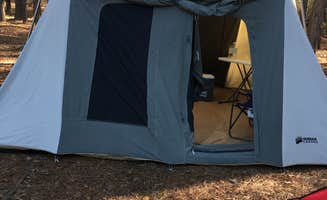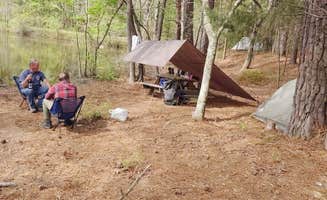Tent camping near Elgin, South Carolina centers around several wildlife-rich areas within a 50-mile radius. Elgin sits at approximately 300 feet above sea level with humid subtropical conditions producing mild winters and hot summers. Summer camping temperatures regularly exceed 90°F with high humidity, creating conditions where mosquitoes and deer flies become particularly active near wetland areas.
What to do
Firefly viewing in late May-June: Congaree National Park hosts synchronous fireflies, a rare natural phenomenon. "We camped here to see the synchronous fireflies, and loved our stay! The group site was plenty big enough for all of the children, the hiking was excellent, and the fireflies were one of the most magical things I've ever seen!" reports Trina W. at Longleaf Campground.
Boardwalk trail hiking: The elevated boardwalk system at Congaree provides accessible wetland exploration for all ability levels. "We took our 2 dogs hiking to the boardwalk trail which led back to the Visitor Center... this was a decent 3+ mile hike our dogs were pooped! The boardwalk provided a unique experience!" notes Marissa H.
Environmental education programs: Youth groups can participate in ranger-led education programs at Carolina Sandhills National Wildlife Refuge. "For the purpose of environmental education programs and research activity, school groups and youth groups are welcome to visit the preserve for ranger led programs and can stay overnight at special rustic group campsites," explains Janet R. Groups must contact the refuge for permits and conduct service learning projects during their stay.
What campers like
Quiet camping atmosphere: The secluded nature of sites provides peaceful overnight stays. "After losing several nights of sleep at our previous campground, this one was a huge relief. Sites were spread out, but also the vibe was less 'party all night' and more 'sleep and then explore the park during the day.' Exactly my kind of vibe!" shares Veronica S. from Blythewood Acres.
Wildlife encounters: The diverse ecosystems support abundant wildlife viewing opportunities. "The fireflies were very pretty and interesting. We saw other wildlife around the campground too. A lizard during a walk during the day. Many frogs during the rain at night," continues Veronica S. The nocturnal frog chorus creates a natural soundtrack unique to the region.
Level campsites at private options: Some private campgrounds offer more developed facilities. "These sites are level and waiting for your RV. Water, sewer, power and dump station on site!" notes Ashley F. about Blythewood Acres, providing an alternative to the more primitive national park options.
What you should know
Insect preparation essential: Biting insects present a significant challenge, particularly in warmer months. "Definitely bring a wagon for packing your stuff in and prepare to be eaten alive by deer flies everywhere you go! The heat in June is also pretty bad," warns Jacinda S. at Longleaf Campground.
Flooding potential: Low-lying areas can flood quickly during heavy rain events. "The first night got a lot of rain and storms and several of the campers from sites farther back left saying they were flooded out. Our site did have some water during the storm but it was gone by morning," reports Veronica S. Another camper notes, "It's lowlands so it floods easily in heavy rains...learned this the hard way!"
Bathroom facilities vary widely: Facilities range from primitive to basic across different campgrounds. "The vault toilet was disgusting, covered in splattered poop and very smelly. I sometimes drove to the visitor center to use the flush toilet and sink there," states Veronica S. Another camper describes toilets as "essentially glorified port-o-potties (a building surrounding a hole in the ground)."
Tips for camping with families
Site selection for ease of access: Choose campsites closest to parking areas when camping with children. "Sites 1-3 are the easiest to get to. We were at site 7, it took about 250 steps from the parking lot to our site," advises Kelly at Bluff Hike In Campground. Another camper recommends, "If you don't want to walk far, get campsite #1. It's right next to the parking lot and closest to the bathrooms."
Bring hauling equipment: A wagon helps transport camping gear from parking areas to walk-in sites. "The heat in June is also pretty bad, so having to go back and forth out to your vehicle to bring your stuff in and out is very difficult even though the path is flat and very short," explains one camper.
Water planning required: No on-site water exists at most primitive campgrounds. Fill containers at visitor centers before setting up camp. One camper notes, "I never did figure out where the spigot was at the visitor center" while another recommends "You can also get water from the Visitor Center (which is a better drive than walk if carrying a large or multiple jugs)."
Tips from RVers
Limited RV accommodations: Most sites near Elgin cater primarily to tent campers with few full-hookup options. Blythewood Acres provides one of the few exceptions with "Water, sewer, power and dump station on site!" according to Ashley F.
Service planning necessary: Cell reception varies widely throughout the area. "We had Verizon service. Enough to use Google image search to look up plants, animals, and mushrooms we had found," reports one Longleaf camper, though service may be spotty in more remote camping areas.
Root challenges for setup: Tree roots create uneven surfaces that complicate tent and equipment placement. "All sites have lots of shade," notes one camper, but this tree coverage comes with challenging ground conditions for setting up camp.



